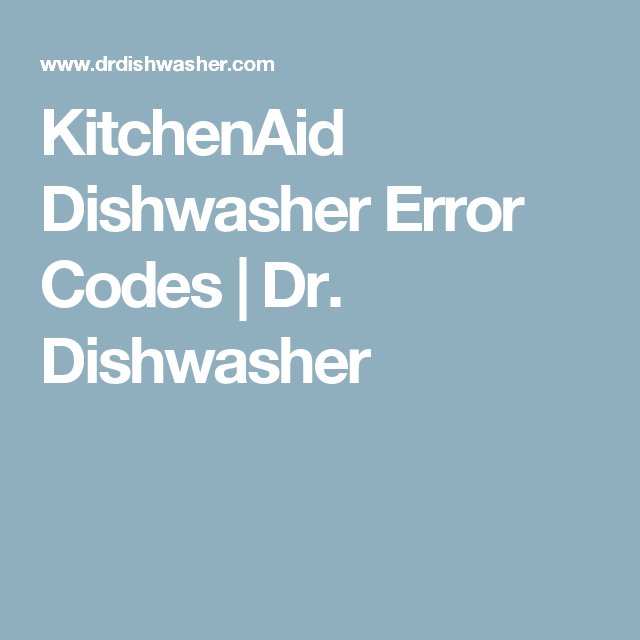
Imagine your dishwasher is like a concert conductor, orchestrating water spray, heat, and soap to clean your dishes. An error code is like the conductor’s baton faltering mid-symphony—something’s amiss, and the show can’t go on until it’s fixed. If you’re wondering whether you can just ignore this and carry on, let’s break it down to ensure you’re making the right choice for your kitchen companion.
Understanding KitchenAid Dishwasher Error Code Oe
Error Code Oe is like your dishwasher’s way of waving a red flag. It commonly indicates a problem with the drainage system. Think of your dishwasher drain as a little water highway that’s supposed to whisk dirty water away. If something clogs that path, the water will back up, and voilà, you’ve got yourself an Oe error. Just like a clogged sink, this is something you’ll want to address sooner rather than later.
You might be asking, “What causes this clog?” Well, it could be debris like food particles or remnants of that delicious pasta sauce that didn’t make it down the drain. Much like how a clogged shower drain can make bath time less than pleasant, a blocked dishwasher drain stops your dishwasher from completing its cycle effectively. The fix, however, doesn’t require a degree in engineering. It might be as simple as cleaning out the filter or ensuring that the drain hose isn’t kinked.
So, what’s the impact of continuing to use the dishwasher with this error? Think of it like driving with your check engine light on—not necessarily disastrous immediately, but certainly not ideal. Not addressing the Oe error can lead to further complications like water leaks, reducing the efficiency of your dishwasher and possibly damaging other components. It’s best to pause and tackle the issue head-on.
Common Causes of the Oe Error Code
Now, let’s delve into some reasons why this pesky code might appear. First up is the filter. The dishwasher filter is like a bouncer at a nightclub—it keeps the unwanted bits out. But over time, if it gets overloaded with grime, it won’t perform as well. Cleaning it regularly prevents clogs and keeps your dishwasher running smoothly.
Another player in this saga could be the drain hose. Picture this hose as the exit ramp for the water to leave your dishwasher. If it’s kinked or blocked, water can’t exit swiftly, leading to the error code. Straightening it out or clearing it of debris might be just what you need.
Lastly, the issue might lie deeper within the drain pump. This device is like a heart pumping water out of the dishwasher. If it’s stuck or clogged, it can’t do its job. Examining it might require a bit more elbow grease, but cleaning it out might just resolve the error.
Is It Safe To Keep Using the Dishwasher?
While the temptation to keep using the dishwasher is strong, especially after a big meal, it’s not advisable with the Oe error still blinking. Why? Well, think of this as akin to ignoring a gas warning light on your car. It’s not immediately catastrophic, but the risks grow with time. You might end up with water leaks in your kitchen, or the error might evolve into a more severe problem if left unchecked.
Continuing to use the dishwasher in this state could lead to inefficiencies. Your dishes might not come out as clean, leaving residues that could be unhealthy. Plus, the prolonged strain on the machine trying to work around this error might reduce its lifespan. So, it’s best to resolve the issue promptly.
If you’re not comfortable dealing with the dishwasher’s innards, calling a professional is always a sound option. They can quickly diagnose and repair any deeper issues, ensuring your dishwasher returns to its prime condition.
Preventative Tips to Avoid Error Code Oe
Avoiding the Oe error is not just about quick fixes—it’s about maintaining your dishwasher regularly. Start by making a habit of cleaning the filter every few weeks. It’s like giving your dishwasher a spa day, keeping it fresh and ready for the next load.
Also, inspect the drain hose occasionally. Make sure it’s free from knots and debris. Think of this like tending to a garden hose during the summer—you want it clear and unblocked for optimal performance.
Lastly, consider running a maintenance cycle with dishwasher cleaner. This process helps clear out any hidden gunk, ensuring your machine remains in top shape. It’s like giving it a refreshing shower, washing away potential problems before they arise.
In summary, while an Oe error might feel like a setback, it’s a manageable hurdle. By addressing it promptly and maintaining your dishwasher regularly, you ensure it serves you faithfully for years to come. So remember, a little effort now saves you from bigger headaches later!